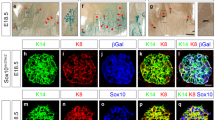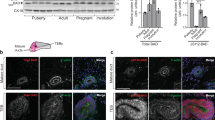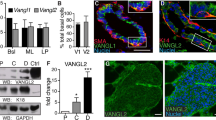Abstract
Expression microarray analysis identified CITED1 among a group of genes specifically upregulated in the pubertal mouse mammary gland. At puberty, CITED1 localizes to the luminal epithelial cell population of the mammary ducts and the body cells of the terminal end buds. Generation of CITED1 gene knockout mice showed that homozygous null mutants exhibit retarded mammary ductal growth at puberty and, in addition, dilated ductal structures with a lack of spatial restriction of the subtending branches. Analysis of CITED1 homozygous null and heterozygous null mammary gland gene expression using microarrays suggested that the mammary-specific phenotype seen in the homozygous null females is due to a disturbance in the transcription of a number of key mediators of pubertal ductal morphogenesis. These include estrogen and TGFβ responsive genes, such as the EGFR/ErbB2 ligand, amphiregulin, whose transcription we suggest is directly or indirectly regulated by CITED1.
This is a preview of subscription content, access via your institution
Access options
Subscribe to this journal
Receive 50 print issues and online access
$259.00 per year
only $5.18 per issue
Buy this article
- Purchase on Springer Link
- Instant access to full article PDF
Prices may be subject to local taxes which are calculated during checkout






Similar content being viewed by others
References
Aldred MA, Huang Y, Liyanarachchi S, Pellegata NS, Gimm O, Jhiang S et al. (2004). J Clin Oncol 22: 3531–3539.
Berking C, Takemoto R, Schaider H, Showe L, Satyamoorthy K, Robbins P et al. (2001). Cancer Res 61: 8306–8316.
Chambers RC, Leoni P, Kaminski N, Laurent GJ, Heller RA . (2003). Am J Pathol 162: 533–546.
Chen CR, Kang Y, Massague J . (2001). Proc Natl Acad Sci USA 98: 992–999.
Daniel CW, Robinson S, Silberstein GB . (1996). J Mammary Gland Biol Neoplasia 1: 331–341.
D'Cruz CM, Moody SE, Master SR, Hartman JL, Keiper EA, Imielinski MB et al. (2002). Mol Endocrinol 16: 2034–2051.
de Groot RP, Sassone-Corsi P . (1992). Oncogene 7: 2281–2286.
Dunwoodie SL, Rodriguez TA, Beddington RS . (1998). Mech Dev 72: 27–40.
Ewan KB, Oketch-Rabah HA, Ravani SA, Shyamala G, Moses HL, Barcellos-Hoff MH . (2005). Am J Pathol 167: 409–417.
Ewan KB, Shyamala G, Ravani SA, Tang Y, Akhurst R, Wakefield L et al. (2002). Am J Pathol 160: 2081–2093.
Furlong EE, Keon NK, Thornton FD, Rein T, Martin F . (1996). J Biol Chem 271: 29688–29697.
Gallagher J, Howlin J, McCarthy C, Murphy EP, Bresnihan B, FitzGerald O et al. (2003). FEBS Lett 551: 8–12.
Humphreys RC . (1999). J Mammary Gland Biol Neoplasia 4: 213–220.
Kenney NJ, Huang RP, Johnson GR, Wu JX, Okamura D, Matheny W et al. (1995). Mol Reprod Dev 41: 277–286.
Kenney NJ, Smith GH, Rosenberg K, Cutler ML, Dickson RB . (1996). Cell Growth Differ 7: 1769–1781.
Kowanetz M, Valcourt U, Bergstrom R, Heldin CH, Moustakas A . (2004). Mol Cell Biol 24: 4241–4254.
Li H, Ahmed NU, Fenner MH, Ueda M, Isselbacher KJ, Shioda T . (1998). Exp Cell Res 242: 478–486.
Luetteke NC, Qiu TH, Fenton SE, Troyer KL, Riedel RF, Chang A et al. (1999). Development 126: 2739–2750.
Martinez-Lacaci I, Saceda M, Plowman GD, Johnson GR, Normanno N, Salomon DS et al. (1995). Endocrinology 136: 3983–3992.
Morse DL, Carroll D, Weberg L, Borgstrom MC, Ranger-Moore J, Gillies RJ . (2005). Anal Biochem 342: 69–77.
Munger JS, Harpel JG, Gleizes PE, Mazzieri R, Nunes I, Rifkin DB . (1997). Kidney Int 51: 1376–1382.
Murtagh J, McArdle E, Gilligan E, Thornton L, Furlong F, Martin F . (2004). J Cell Biol 166: 133–143.
Nair SS, Chaubal VA, Shioda T, Coser KR, Mojamdar M . (2001). Pigment Cell Res 14: 206–209.
Negoescu A, Lafeuillade B, Pellerin S, Chambaz EM, Feige JJ . (1995). Exp Cell Res 217: 404–409.
Nicolas M, Wolfer A, Raj K, Kummer JA, Mill P, van Noort M et al. (2003). Nat Genet 33: 416–421.
O'Connell C, Martin F . (2000). Cell Death Differ 7: 360–367.
Prasad ML, Pellegata NS, Huang Y, Nagaraja HN, de la Chapelle A, Kloos RT . (2005). Mod Pathol 18: 48–57.
Prasad ML, Pellegata NS, Kloos RT, Barbacioru C, Huang Y, de la Chapelle A . (2004). Thyroid 14: 169–175.
Robinson SD, Silberstein GB, Roberts AB, Flanders KC, Daniel CW . (1991). Development 113: 867–878.
Russo J, Ao X, Grill C, Russo IH . (1999). Breast Cancer Res Treat 53: 217–227.
Shioda T, Fenner MH, Isselbacher KJ . (1996). Proc Natl Acad Sci USA 93: 12298–12303.
Shioda T, Lechleider RJ, Dunwoodie SL, Li H, Yahata T, de Caestecker MP et al. (1998). Proc Natl Acad Sci USA 95: 9785–9790.
Sid B, Sartelet H, Bellon G, El Btaouri H, Rath G, Delorme N et al. (2004). Crit Rev Oncol Hematol 49: 245–258.
Silberstein GB, Daniel CW . (1987). Science 237: 291–293.
Soulez M, Parker MG . (2001). J Mol Endocrinol 27: 259–274.
Stern DF . (2003). Exp Cell Res 284: 89–98.
Stewart HJ, Rougon G, Dong Z, Dean C, Jessen KR, Mirsky R . (1995). Glia 15: 419–436.
Tang S, Han H, Bajic VB . (2004). Nucleic Acids Res 32 (Database issue): D533–D536.
Verrecchia F, Chu ML, Mauviel A . (2001). J Biol Chem 276: 17058–17062.
Wiesen JF, Young P, Werb Z, Cunha GR . (1999). Development 126: 335–344.
Williams JM, Daniel CW . (1983). Dev Biol 97: 274–290.
Wu L, Wu Y, Gathings B, Wan M, Li X, Grizzle W et al. (2003). J Biol Chem 278: 15192–15200.
Xie L, Law BK, Aakre ME, Edgerton M, Shyr Y, Bhowmick NA et al. (2003). Breast Cancer Res 5: R187–98.
Xie W, Paterson AJ, Chin E, Nabell LM, Kudlow JE . (1997). Mol Endocrinol 11: 1766–1781.
Yahata T, de Caestecker MP, Lechleider RJ, Andriole S, Roberts AB, Isselbacher KJ et al. (2000). J Biol Chem 275: 8825–8834.
Yahata T, Shao W, Endoh H, Hur J, Coser KR, Sun H et al. (2001). Genes Dev 15: 2598–2612.
Zeps N, Bentel JM, Papadimitriou JM, D'Antuono MF, Dawkins HJ . (1998). Differentiation 62: 221–226.
Zhou A, Scoggin S, Gaynor RB, Williams NS . (2003). Oncogene 22: 2054–2064.
Acknowledgements
We gratefully acknowledge the support of Bohdan Wasylyk. We thank Joseph Mooney of the Biomedical Facility and Alison Murphy of the Conway Institute Microarray Core Facility, UCD for their technical assistance.
This work was supported by grants from Science Foundation Ireland and HRB, Ireland [inclusive of the Research Programme Grant: Breast Cancer Metastasis: Biomarkers and Functional Mediators] and IRCSET, Ireland; the EU RTN on Mammary Development and by US NIH Grant (CA082230) (to TS).
Author information
Authors and Affiliations
Corresponding author
Additional information
Supplementary Information accompanies the paper on Oncogene website (http://www.nature.com/onc).
Rights and permissions
About this article
Cite this article
Howlin, J., McBryan, J., Napoletano, S. et al. CITED1 homozygous null mice display aberrant pubertal mammary ductal morphogenesis. Oncogene 25, 1532–1542 (2006). https://doi.org/10.1038/sj.onc.1209183
Received:
Revised:
Accepted:
Published:
Issue Date:
DOI: https://doi.org/10.1038/sj.onc.1209183
Keywords
This article is cited by
-
CITED1 as a marker of favourable outcome in anti-endocrine treated, estrogen-receptor positive, lymph-node negative breast cancer
BMC Research Notes (2023)
-
An Integrative Single-cell Transcriptomic Atlas of the Post-natal Mouse Mammary Gland Allows Discovery of New Developmental Trajectories in the Luminal Compartment
Journal of Mammary Gland Biology and Neoplasia (2021)
-
Estrogen receptor-α signaling in post-natal mammary development and breast cancers
Cellular and Molecular Life Sciences (2021)
-
The V-ATPase a2 isoform controls mammary gland development through Notch and TGF-β signaling
Cell Death & Disease (2016)
-
TFAP2C expression in breast cancer: correlation with overall survival beyond 10 years of initial diagnosis
Breast Cancer Research and Treatment (2015)



